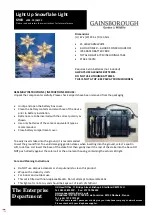
35-201578-165 (12/06)
and removed from the remaining portion of the housing. To
prevent water intrusion into the luminaire tightly wrap the Teflon
tape (included with the luminaire) around the portion of the
threads that will be engaging into top casting. The top casting
can then be threaded onto the mounting arm and the jam nut
fully tightened. To ensure proper mounting the top casting of
the luminaire should be fully threaded onto the mounting de-
vice (arm, conduit, slip fitter), which is at least 4 complete turns.
The jam nut should then be tightened to the upper casting.The
luminaire can then be re-mounted to the top casting, wiring
completed and secured back into place. See Figure 4.
B.
LEVELING AND ORIENTING
Prior to leveling it is recommended that reflector be oriented in
the proper position. Determine the reflector orientation as noted
on the label on the reflector flange. Rotate the luminaire into
proper position. For those luminaires ordered with the leveling
device the luminaire may be secured in a vertical position by
loosening the four setscrews and positioning the luminaire in a
vertical position. A level may be used to verify “plumb” by
laying the level across the flats surrounding the leveling device’s
mounting bolts or under top casting. Setscrews should then be
tightened in alternating crossing pattern to a torque of 4-6 foot-
pounds. See Figure 5
Figure 4
1-1/2in. NPT Connection
Jam Nut
Street Side
Figure 5
Set Screws
Level
C.
GLOBE INSTALLATION
To install the globe and globe ring (shipped in a separate car-
ton) the two hex head screws on the hinge side of the globe will
need to be aligned with the pre-drilled hinge holes on the lumi-
naire casting. Fully tighten the two screws (4-5 ft-lbs).
Swing globe ring into closed position, position eyebolt in mount-
ing slot and fully tighten wing nut.
WIRING
Make all electrical connections in accordance w/ the national
electric code and any applicable local code requirements
Verify that supply voltage is correct by comparing it to
nameplate.
Do not remove insulated connectors from wires not needed for
required voltage connection.
1. Open the top casting by loosening top wing nut, swing eye bolt
out of mounting slot and rotate top casting open.
See Figure 6.
3. Check luminaire nameplate for ballast type (single or multi-
volt)
4. Route and secure supply leads through the internal cable clamp
and connect to terminal board.
Note: Terminal board will accept supply leads ranging in size
from AWG No. 14 thru No. 6 (check nameplate for minimum
temperature requirements and electrical data).
5. Swing castings together, position eyebolt between mounting
slot and fully tighten wing nut.
LAMP ACCESS/INSTALLATION AND REFLECTOR ORIENTATION
1.
Open globe by loosening lower wing nut, swinging eyebolt out
of mounting slot and rotate door ring open. See Figure 6.
2.
Install lamp (see Lamp Section)
3.
Reflector may be rotated in 90-degree increment by removing
four mounting screws and rotating reflector to desired
orientation. For smaller rotational changes, see LEVELING AND
ORIENTING Section.
4.
Swing door and globe back into place, position eyebolt in the
mounting slot and fully tighten wing nut.
LAMP INSTALLATION
Note: Use only lamps specified on nameplate. Observe lamp
manufacturer’s recommendations and restrictions on lamp
operation; particularly ballast type, burning position, etc.
LAMP TIGHTNESS –
The lamp should be securely inserted to ANSI-
C13611 specified torque of 35 inch-pounds, which is best achieved
by very firmly tightening to ensure application of sufficient torque.
Tightening must be sufficient to fully depress and load center contact
of socket.
Note: Use of lubricants on lamp base or socket can cause rapid
lamp failure and voids fixture warranty.
MAINTENANCE AND CLEANING
It will occasionally be necessary to clean door glass and shield to
maintain light levels. Frequency of cleaning will depend on ambient
dirt levels and minimum light level which is acceptable. Door glass
should be washed in a solution of warm water and any mild, non-
abrasive household detergent, rinsed with clean water and wiped
dry. Should optical assembly become dirty on inside, wipe reflector
and clean door glass in above manner, and replace any damaged
gasket.
Light output of luminaire is dependent on age of lamp. In applica-
tions where light levels are critical replace lamps before they burn
out. Lamp manufacturer can provide data showing how lamp light
output decreases with use.
Figure 6
Top Casting
Wing Nut
and Eye Bolt
g
GE Lighting Solutions is a subsidiary of the General Electric Company. Evolve and other trademarks belong to GE Lighting Solutions. The GE brand and logo are trademarks of the General Electric Company.
© 2011 GE Lighting Solutions. Information provided is subject to change without notice. All values are design or typical values when measured under laboratory conditions.
GE Lighting Solutions • 1-888-MY-GE-LED • www.gelightingsolutions.com
1
6 9 4 3 5 3 3
-
-
-
- 8 8 8




















